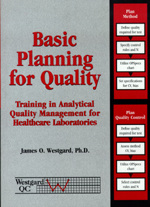Basic Planning for Quality
QP-11: Blood Gas Applications
The Quality Planning Process in action! Examples in this lesson show how to choose control rules and materials for pH, pO2, pCO2and more. The differences between POC and instrument analyzers are also discussed. (Preview)
- Quality requirements
- Method imprecision and inaccuracy
- Example applications
- Planning and implementation strategies
- References
Blood gas measurements are often performed in Point-Of-Care (POC) settings as well as larger clinical or pulmonary laboratories. Patients may be monitored during surgery and in the recovery room via the POC tests. Later, when the patients are moved back to their hospital rooms, they may be monitored by measurements performed in a central clinical laboratory or pulmonary function laboratory. The comparability and consistency of test results will be important.
When a new POC analyzer is obtained, the performance of the analyzer should be evaluated by comparison to the measurements being performed in an established laboratory, such as the central clinical chemistry laboratory or the pulmonary function laboratory. Method validation studies will provide estimates of imprecision and bias that can then be used for planning QC procedures.
Quality requirements
The US CLIA criteria for acceptable performance in proficiency testing are as follows:
Blood gas pH Target Value +/- 0.04 pH unit
Blood gas pCO2 Target Value +/- 5 mm Hg or +/- 8% (greater)
Blood gas pO2 Target Value +/- 3 SD
To quantify the requirement for pO2, results from an AACC/CAP proficiency testing survey during 1999 showed the following SDs and CVs for pO2 for "all" analyzers, which represent approximately 3500 laboratories that participated in the survey:
- At 145 mm Hg, SD=6.7 mm Hg, CV=4.6%
- At 115 mm Hg, SD=7.1 mm Hg, CV=6.1%
- At 118 mm Hg, SD=7.5 mm Hg, CV=6.4%
- At 59 mm Hg, SD=14.7 mm Hg, CV=25.1%
- At 144 mm Hg, SD=7.2 mm Hg, CV=5.0%
The SD and CV for the 4th specimen (59 mm Hg) appear to be inconsistent with the rest of the figures and further inspection showed that different manufacturers' systems provided large differences in their mean values, demonstrating that the "all" or overall SDs and CVs may reflect a large contribution from systematic errors between different types of analyzers. Averaging the results from the other four specimens gives an SD of 7.1 mm Hg and a CV of 5.5%. The CLIA requirement for pO2 can therefore be estimated to be about +/- 16.5%.
Method imprecision and inaccuracy
To estimate the imprecision of the analyzer, initial method validation studies should include a replication study performed over a period of 20 days. Typically, three different control materials would be analyzed and the SDs and CVs calculated for each level. To estimate inaccuracy or bias, a comparison of methods experiment should be performed on a minimum of 20 and preferably 40 fresh patient samples. The paired data could be analyzed by regression and t-test statistics.

 We invite you to read the rest of this article
We invite you to read the rest of this article
Note: This material is covered in the Basic Planning for Quality manual, which is availalbe in our online store. You can download the Table of Contents and additional chapters here.
Updated and expanded coverage of these topics can be found in Assuring the Right Quality Right,also available in our online store. You can also download the Table of Contents and additional chapters here.
Finally, you can access materials online on these topics by enrolling in the Management and Design of Analytical Quality Systems course course.
